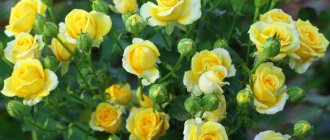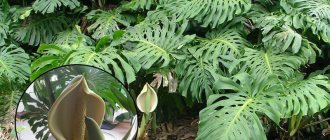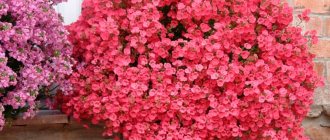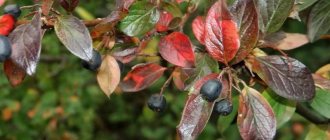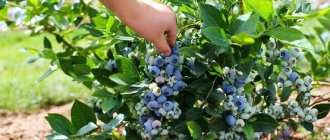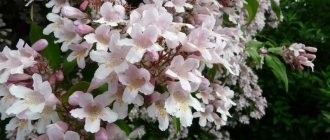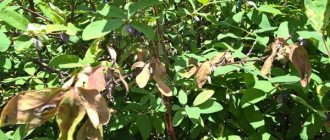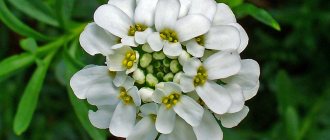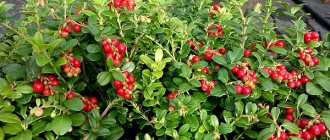Varieties and varieties
There are different varieties and varieties of plants that differ from each other in terms of life, fruiting and external characteristics.
Alpine
This variety has white or yellow flowers. The stems reach a height of up to ten centimeters. It is grown as a one to two year old plant.
Holostem (Siberian)
A variety of alpine poppy that grows in the valleys of Siberian rivers. Characterized by early, long flowering. The stems reach a length of 35 centimeters. The flowers take on shades of white, yellow and orange.
Samoseyka Shirley (field, wild)
The stems of this variety reach a height of half a meter and have a bristly covering. The flowers are up to 10 centimeters in diameter and take on a uniform color of various colors. Shirley blooms in late spring, early summer.
Oriental
Perennial variety. It is considered one of the most beautiful varieties. It reaches a height of one meter. The flowers are characterized by their large size and rich bright red color. In addition, there are artificially bred subspecies that have flowers of different colors and textures.
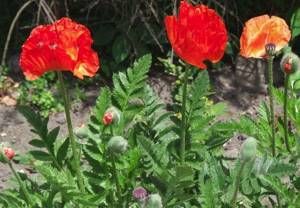
Decorative
Decorative poppy includes more than a hundred varieties, reaching a height of up to one meter. There are both annual, biennial and perennial subspecies. Characterized by large flowers, resistant to temperature fluctuations.
Terry
This subspecies is also called peony-shaped. It is an annual plant. The stems reach a height of 90 centimeters. The flowers are large, double, similar in appearance to peony flowers. Most often pink, but there are varieties with various shades.
Icelandic
It is a perennial plant. The flowers take on a variety of colors: white, yellow, red, pink. Flowering begins in May and continues all summer until autumn.
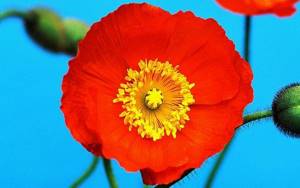
LiveInternetLiveInternet
MACIES. Poppy has a bright and varied manifestation in people's lives, which is why it received figurative names and became the hero of various beliefs and rituals, sometimes to such an exotic degree that impressionable people may feel uneasy from these stories. In the European West, the poppy is called "blind blow" because of its striking bright red color, and "weak head" because its smell can cause weakness and headaches, and "ghost flower" because according to one belief These flowers are believed to suck blood if you walk through a poppy field.
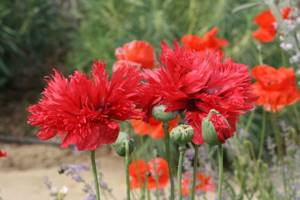
Catholics consider poppies to be the flowers of angels and decorate churches with them on the day of the Descent of the Holy Spirit. The Chinese consider the poppy a symbol of a safe retirement and a beautiful holiday. They also consider the poppy to be a symbol of evil and decay when it comes to the opium obtained from it.
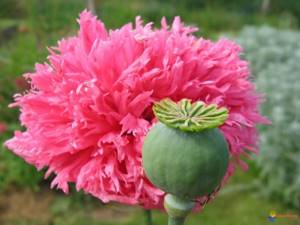
Among Christians, the poppy did not receive such a wide figurative embodiment, but still became a symbol of mortal sleep and self-sacrifice, personifying the suffering of Christ. ANNUAL POPPIES. Bright, vibrant poppy flowers with delicate silky petals are dear to the hearts of many gardeners. Among annual poppies, the most popular is the soporific poppy, or opium poppy (Papaver somniferum). This is a colorful plant with a height of 40 to 120 cm with bluish leaves and large (10-15 cm in diameter) flowers, single or double, with whole or cut petals. They are distinguished by a rich range of colors and can be white, pink, salmon pink, light orange, red, cherry, raspberry, lilac, dark purple - monochromatic or bicolor.
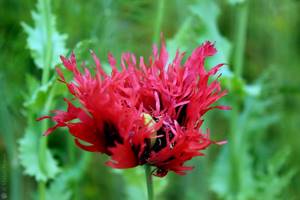
1 g contains from 2500 to 5000 poppy seeds, which remain viable for 3-4 years. They are sown directly into the ground in a permanent place, since this plant does not tolerate transplantation. Sow both before winter (in November) and in spring - from late March to May. The seeds are planted shallowly. When sowing in spring, germination occurs within a week, sometimes a little later. As soon as the seedlings grow a little, they are thinned out, leaving a distance of 15-25 cm between plants. Thinning should not be delayed, since in the future the plants will form untidy bushes. Flowering occurs after two months and lasts up to three weeks. To be able to admire blooming poppies throughout the summer, seeds should be sown at different times. PERENNIAL POPIES. ALPINE POPPY (P. alpinum) is a perennial plant, but does not live long, so it is often grown as a biennial. It is unusually elegant: above a rosette of pinnately dissected grayish-green leaves rises a thin but strong peduncle about 15 cm high, which bears a drooping bud. The bud opens and turns into a charming flower of white, yellow, yellow-orange, and less often red. The diameter of the flower is about 5 cm; alpine poppy blooms in May-June for at least two months. ANOMAL POPPY, or rejected (Papaver anomalum) Album is a rare perennial about 40 cm high with snow-white flowers that are decorated with yellow stamens. Carved bluish pubescent leaves are collected in a dense basal rosette. When sown early, it blooms in the first year from mid-summer to autumn. On a well-developed bush, several dozen flowers with a diameter of 5-8 cm can bloom simultaneously! An absolutely winter-hardy plant.
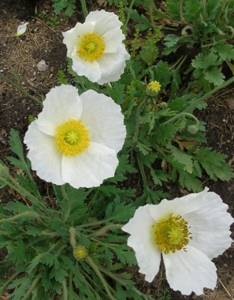
POPPY (P. rupifragum), which is also called Spanish poppy (Spanish Poppy), is a perennial 30-60 cm high unknown to a wide range of gardeners. It has a dense, silvery-tinged rosette of pretty basal leaves and satiny semi-double flowers of orange color. The Tangerine Parfait variety has semi-double flowers. This is one of the few poppies that blooms continuously from June until the end of summer, provided that faded flowers are regularly removed. In June the flowering is unusually abundant.
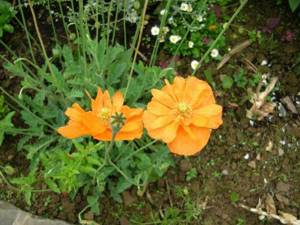
ORIENTAL POPPY, or Turkish (P. orientale) is a large perennial poppy 60-120 cm high. It has beautiful pinnately dissected leaves up to 30 cm long and rather hard stems covered with hairs. The flower bowls reach 10-20 cm in diameter - bright, usually with a black base of the petals. Inside the flower there are many attractive black and blue stamens around the capitate pistil. The color of the petals can be orange, red, dark red, white, pink, lilac-pink. The popular variety Diamond has fiery red flowers, the variety Carneum has pink-salmon flowers, the variety Princess Victoria Louise has salmon-red petals, and the Nimble dwarf with scarlet-red flowers does not exceed 30-40 cm. There are garden forms with semi-double and double flowers. Oriental poppy blooms in May-June for 12-15 days.
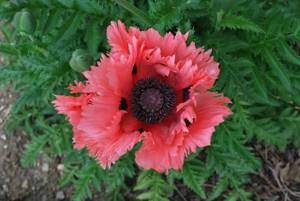
POPPY (Papaver bracteatum) is a large perennial poppy. Leaves are basal, pubescent, pinnately dissected, up to 45 cm long with oblong-lanceolate segments. Height with peduncles up to 130 cm. Endangered species. Endemic to the foothills of the North Caucasus. It is found in the Stavropol Territory in the Caucasian Mineral Waters region (laccolithic mountains Beshtau, Lysaya, Byk, Camel), in Kabardino-Balkaria, North Ossetia, Chechnya, on the Tersky and Sunzhensky ridges from Mozdok to Grozny. Indicated also for s. Harvest in Kabardino-Balkaria. Rare throughout its range, found in small groups and single specimens. Grows in meadows, among bushes and on gravelly slopes at an altitude of 200-700 m above sea level. seas. Natural regeneration is insufficient.
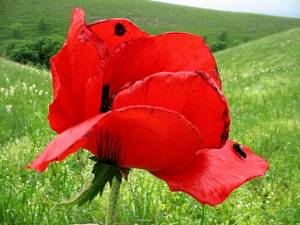
CARE OF POPPIES. Perennial poppies are not only very decorative, but also quite undemanding. They grow and bloom best in warm, well-lit areas, although they tolerate light partial shade. They prefer loose, fertile, moderately moist and always well-drained soils, neutral or alkaline. They are also characterized by sufficient drought resistance and good frost resistance. Only the poppy should be covered with spruce branches for the winter.
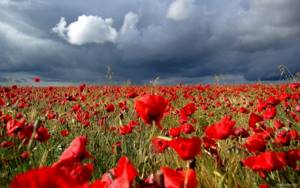
1 g contains 6,500 alpine poppy seeds, 9,600 anomalous poppy seeds, 13,000 rock poppy seeds and from 3,000 to 5,000 oriental poppy seeds. Seeds of perennial poppies are best sown immediately in a permanent place before winter or early spring (March-April). Sow scatteredly, not densely, lightly embed into the soil with the back of a rake and cover the top with a non-woven covering material secured to pegs or in some other way. Some gardeners sow in rows in the spring, sow quite rarely, sprinkle a thin layer of sifted peat on top and water daily in the morning and evening for about two weeks (until shoots appear). Grown seedlings are thinned at a distance of 10-20 cm - alpine, anomalous and rock poppies and 30 cm oriental poppy. Oriental poppy seeds are also sown in spring or mid-summer in cold greenhouses.
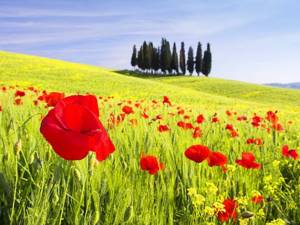
If there are few seeds, they are sown in November-December in wide pots, which are left in the garden until spring, and then brought into a room at room temperature for germination. You can sow perennial poppies in pots in the spring - in March-April. They are sown rarely, and the seeds of poppies, especially rejected and rock poppy seeds, are not sprinkled with soil on top, but eastern and alpine poppies, if desired, are sprinkled with a layer of no more than 1-2 mm. Seedlings dive straight to a permanent place, since adult plants do not tolerate transplantation well.
Grown-up seedlings of anomalous, rock and alpine poppies, which are especially sensitive to transplantation, can be cut out of a bowl with a knife along with a square of soil and carefully, preserving the lump of soil as much as possible, transplanted into a flower garden. To achieve the most decorative effect, plant young plants in large groups - during mass flowering they will give you an unforgettable experience. Alpine and oriental poppies consistently self-sow.
Why is it useful?
Many people have the misconception that poppy is a narcotic drug. In fact, only the milk of immature plants has a psychotropic effect. The seeds have beneficial properties and are used for medical, culinary and cosmetic purposes.
See also
Description and varieties of crocosmia, planting and care in open groundRead
Medicine
Poppy seeds contain substances used for medicinal purposes.
Codeine
A substance used to combat cough. Has an analgesic effect.
Papaverine
Antispasmodic; used to weaken the tone of smooth muscles of muscles and internal organs.
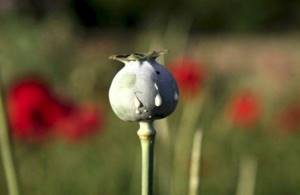
Morphine
Used in medicine as a strong pain reliever. Extracted from the juice of the opium poppy.
ethnoscience
In addition to official medicine, poppy, due to its beneficial properties, has become widespread in folk medicine. The plant is used as an analgesic, hypnotic, and helps with diarrhea, fatigue and other diseases of the body.
Hypnotic
An infusion of boiled poppy seeds is used as a sleeping pill. The seeds are infused in a thermos for three hours. The tincture is consumed before going to bed.
Painkiller
In addition to its hypnotic effect, poppy has a strong analgesic effect. The seeds are added to food, their juices help to cope with headaches and speed up the healing of the body after injuries or illnesses.
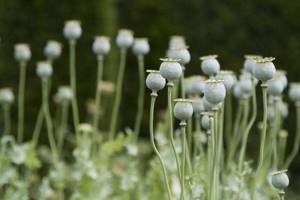
For diarrhea
The plant fibers contained in the seeds regulate the functioning of the stomach, eliminate constipation, help relieve abdominal pain and relieve diarrhea.
From fatigue
A decoction of poppy seeds, among other things, helps reduce body fatigue.
For migraine
Poppy infusion is used to combat migraines and frequent headaches. Migraine is treated by taking the infusion three times orally in a volume of 50 milliliters.
Boosting immunity
Eating poppy seeds helps increase the body's resistance to diseases. The seeds contain zinc, which helps reproduce white blood cells and enhances the body's defense against bacterial invasion.
For bronchitis and laryngitis
A decoction of poppy, thyme and violet helps thin mucus. One spoon of the mixture is poured with boiling water and infused for ten minutes.
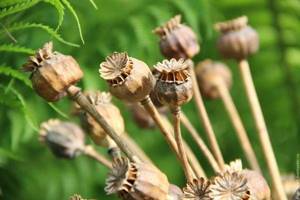
Stopping the bleeding
Preparations based on poppy seeds have a hemostatic effect, so they are used to stop bleeding.
Oncology
The seed extract is used in oncology to prevent the appearance of metastases.
Fighting sweating
Poppy-based preparations reduce excessive sweating.
Cooking
In addition to medicinal use, poppy seeds are actively used in cooking. The seeds have a spicy taste and complement mushroom dishes and various sauces. Poppy seeds are widely used in the bakery and confectionery industry: buns with poppy seeds can be purchased in any supermarket.
Landscape design
Due to their unusually beautiful appearance, the flowers of the plant are used in landscape design. They will decorate any summer lawn or garden area.
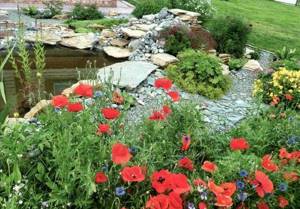
Cosmetology and creativity
Essential oils obtained from the seeds of this plant have become widespread in cosmetology and are used to make homemade masks and body lotions.
Contraindications for use
Due to the opium content, the seeds can cause addiction and side effects such as poisoning. It is not recommended to use poppy in food if you have an individual intolerance, as well as with alcohol dependence, liver disease and heart failure.
Planting and care
Poppies are undemanding in terms of planting location and care, but following certain rules will allow them to develop better and bloom faster.
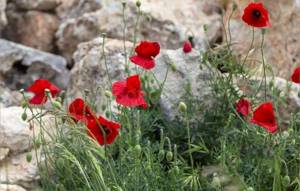
Selecting a location
Poppy grows best in areas that receive full sun. Most varieties require fertile soil, so the soil needs to be dug up with compost.
Deadlines
In regions with mild climates, seeds are sown in autumn or late winter. To sow at a later date, the seeds need to be kept in the refrigerator for two months.
Spring planting
In spring, poppy planting is carried out after the snow has melted and the soil has thawed.
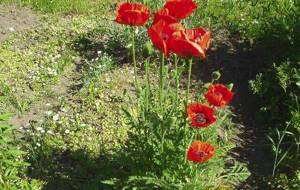
Autumn
Autumn planting is the most preferred option. At the same time, the plants grow stronger and bloom faster.
See also
How to propagate gladioli by seeds, bulbs and children, preparation for plantingRead
Watering
Poppies are drought-resistant and therefore do not require special watering conditions. At the very beginning of the growing season, flowers should be watered twice a week.
Fertilizer
Fertilizing the plant with Kemira Universal solution, as well as fertilizing with complex fertilizers during flowering, has a positive effect on growth.
Transfer
You should not replant garden poppies. The plant does not take root in seedlings and may die.
Trimming
The plant does not need regular pruning, but after flowering it is worth removing dead leaf blades in order to preserve its appearance.
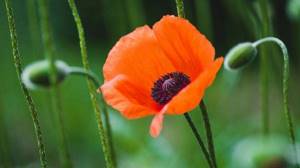
Wintering
Faded annuals should be removed from the garden bed before winter. Perennial specimens - cut to the level of the bed. In areas with cold winter climates, the beds should be covered with spruce branches.
After flowering
For perennial plants, after they have flowered, dried stems and leaves should be trimmed. The above-ground part of the plant is cut off near the ground.
Poppies flowers - growing
Oriental poppy is considered easy to care for. Its root system is located very deep in the ground. This allows you to get food and water during the driest times. There are small hairs on the shoots, they protect the plant from overheating. This makes it possible to make watering less frequent. Moderate soil moisture is perfect for poppies.
This plant does not need annual replanting. It will only be needed in 8-10 years. Poppies are quite frost-resistant. They withstand cold winters very well. They are not afraid of even frosts reaching minus 30-35 degrees.
The acidity level is preferably neutral. But even in acidic soil, the flower will be able to continue to grow; this will only affect the size of the buds; they will be significantly smaller in size.
This plant grows best when planted far apart, about 70 centimeters apart. The stems are quite tall and not strong; with gusts of wind they can completely fall to the ground.
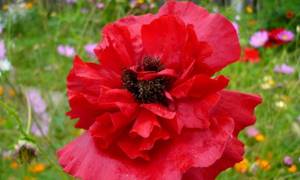
Therefore, tying is recommended for poppies. At the end of flowering, the seeds spread very quickly over the surface of the earth.
The plant has a dormant period. At the end of flowering, the shoots die and need to be cut off. Closer to September, the poppy will recover and continue its growth. Some gardeners often mistake this process for death and plant other flowers in this place. This destroys dormant poppies.
Reproduction methods
In order to obtain oriental poppy, propagation is chosen by dividing the bush or using seeds.
Most often, gardeners use the method of propagating oriental poppy seeds.
To do this, you do not need to plant them in a temporary place. The root system grows quickly, which makes it undesirable to replant the plant.
- The seeds are placed in the soil in a place prepared for them; it is recommended to do this in the off-season.
- The seeds are very small in size; there is no need to sprinkle them with soil.
- It is important to simply cover them with plastic or other transparent covering.
- After the first shoots appear, the crops must be thinned, this must be done several times.
- Flowers will begin to appear only next year.
The method of dividing a bush is used much less frequently. Transplantation has a rather unfavorable effect on the development of the plant; the root system is well developed and very deep.
But during the dormant period, you can divide the plant into several parts.
Further planting is carried out after thorough weeding and fertilizing of the soil. There is no need to cover the new plant for the winter.
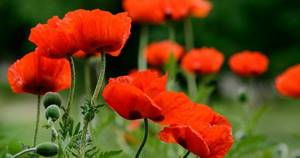
Due to its ease of care, poppies are often grown in garden plots. This plant blooms very beautifully, and cut flowers can perfectly decorate any interior, giving it nobility and style.
Is it legal to grow oriental poppy for ornamental purposes?
Whether oriental poppy can be grown for decorative purposes is a rather controversial issue. You can always prove that you are not using it for purposes other than decorating your garden.
But there are some articles in the administrative and criminal code that prohibit the cultivation of this plant to all citizens of our country, without exception.
Oriental poppy contains oripavine. This substance is classified as a narcotic. And any plant that contains narcotic drugs is illegal in our country.
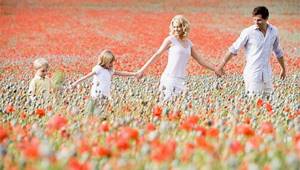
The Decree of the Government of the Russian Federation of November 27, 2010 N 934 states that the cultivation of sleeping pill poppy and other varieties of poppies that contain narcotic drugs is prohibited. As a result, the Oriental poppy is considered a prohibited plant by law.
The legislation also states that planting plants that contain narcotic substances is subject to criminal liability only in large and especially large quantities.
A planting of more than 10 plants is already considered large, and if there are more than 200 plants growing in the garden, then this planting is defined as a particularly large planting.
We can conclude that if you grow just a few oriental poppy flowers, no more than ten, near your home, you will not be held criminally liable.
The punishment you may face will only consist of a fine issued.
Whether it is worth depriving yourself of the pleasure of admiring the beautiful scarlet flowers is up to you to decide. But still be careful.
Depending on the type of plant, they are either sown into the soil immediately, or the diving method is used. Growing seedlings for annual poppy flowers from seeds is not advisable, because due to the weak root system, almost all of them will die during transplantation. Perennial plants can be planted using seedlings. Transplantation to a permanent place is carried out after the formation of the first pair of full-fledged leaves.
How to plant poppy?
This flower does not need special care. Regardless of whether the plant is an annual or perennial, it is recommended to water it in dry weather (2-3 liters per bush), remove weeds and loosen the soil around the flower. Perennial poppy is a flower whose care includes obligatory covering with foliage for the winter. Annuals are removed immediately after flowering and the soil is dug up. Perennials are pruned at ground level.
Poppy - reproduction
For lovers of these plants, it is important to know how to increase the number of existing ones without purchasing new specimens. After the buds wither, the poppy flower develops a seed capsule. The material collected from them is the main element for reproduction. In addition, this can be done by dividing the rhizome or green cuttings.
The plant is considered unpretentious, but unfavorable weather conditions can lead to the appearance of some diseases. The garden poppy flower can be affected by:
- Powdery mildew. A fungal disease that leads to the appearance of a white coating on the leaves. You can treat flowers with a solution of soda in the amount of 40 g per bucket of water.
- Downy mildew. Red-brown spots appear on the leaves, which gradually lead to deformation of the leaves. The fight occurs in the same way as with powdery mildew.
- Alternaria. Spotty coating on leaves and bolls. Treatment is carried out with Bordeaux mixture or “Fundazol”.
- Fusarium. Wilting occurs as a result of spots on leaves and stems. There is no treatment; all diseased plants are removed immediately.
Among the pests are the following:
- Weevils - damage roots. Before sowing, granulated 10% “Bazudin” is added to the soil.
- Poppy secretive proboscis feeds on leaves. The seedlings are treated with Chlorophos solution.
- Aphids - attack stems and bolls. Spraying is carried out with “Aktara” or “Aktellik”.
Diseases and pests
Poppies are susceptible to fungal and bacterial diseases, as well as pest attacks.
Root rot
Root rot is a fungal disease that affects many garden crops. Due to its action, plant tissues begin to rot. To prevent the formation of rot, the seeds should be treated with potassium permanganate and the soil should be disinfected with bleach.
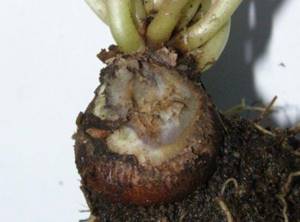
Powdery mildew
Powdery mildew poses the greatest threat to poppy plants. It is characterized by the appearance of a white coating on the stems and leaves and leads to the death of the plant. It is treated with a solution of copper oxychloride.
black spot fungus
An indicator of damage is the appearance of dark spots between the veins of the leaves. Severely affected plants die before seed production.
Aphid
An insect that feeds on plant juices is a dangerous pest. In addition, it is capable of spreading plant diseases and causing gall-like formations.
Spider mite
A harmful mite that affects almost all types of ground crops. It bites through plant cells and feeds on plant sap. It does not tolerate high humidity, therefore, to prevent its occurrence, plants should be sprayed with warm water.
Possible difficulties
The main difficulties when growing garden poppies can be: difficulties in providing the soil with the right amount of moisture and nutrients, lack of care, incorrectly selected place for growing, as well as dense planting of poppies.
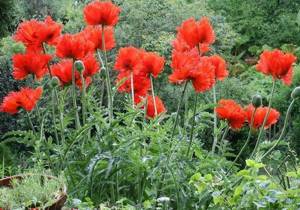
Increased soil moisture
Poppy grows well in damp, ameliorated soils, but does not tolerate excessive moisture, therefore, in order to avoid plant death, water stagnation at the roots should not be allowed.
Lack of nutrients in the soil
The culture requires fertilized soil. With insufficient nutrients it grows slowly, the flowers may grow small in size and not bright enough.
Dense planting
If planted too closely, the flowers will grow small, which will affect the appearance of the bed.
Poor care
Wilted flowers must be removed in a timely manner, otherwise seed pods will appear and the bush will stop blooming. Pruning extends the poppy's flowering cycle.
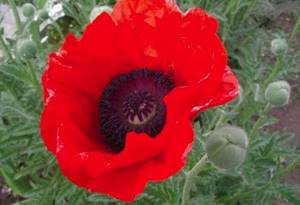
Wrong place
Poppy is a light-loving crop, so planting it in the shade will result in it not blooming due to lack of sunlight.
How to grow from seeds?
In areas with mild winters, seeds are sown in the fall to undergo stratification or sown in early spring. In spring, after 15 days, the seeds germinate. Before sowing, the soil is loosened with a rake, and the seeds are sown on the surface of the soil. The soil must be kept moist. When the sprouts grow a little, you can thin them out; this is best done with scissors.
But what should you do if you really want to recreate a clearing with poppies on your property?
and other meadow grasses? Take heart, because the genus Papaver has more than 100 species, and only a few are prohibited. You can choose from annual and perennial poppies.
Annual self-seeded poppy fits well into natural-style plantings
The most famous representative of the first group is considered to be the poppy (P. rhoeas). It fits perfectly into natural-style plantings. This annual blooms profusely from June until autumn. Less common are the stunningly beautiful annual modified poppy (P. commutatum) and peacock poppy (P. pavoninum).
Among the perennials, it is worth highlighting the bare-stemmed poppy (P. nudicaule), which blooms from May until late autumn. Depending on the variety, its flowers are double and simple, white, yellow and orange, with a diameter of 2.5-6 cm (in the compact variety 'Popsale' they are as much as 10 cm in diameter). So, as we see, there are plenty of legal poppies.
You can find seeds of a wide variety of varieties on sale, take a look at our market (section Papaver seeds) and choose yours!
Eastern papaver Khalif 22 RURAgrifirm Search Eastern papaver Sultan 22 RURAgrofirm Search Peony papaver Salsa 16 RURAgrofirm Search Peony papaver Dance fantasy 16 RURAgrofirm Search
A classic summer tandem - red poppies and blue cornflowers. To recreate such a lawn, select a larger area - this will make the composition look especially impressive.
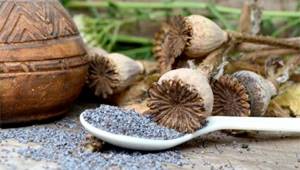
Classic summer tandem - red poppies and blue cornflowers
Poppy 'Helen von Stein' petals in bud look as if they are crushed. As the flower opens, the petals become fully erect.
Poppy 'Helen von Stein' petals in bud look as if they are crushed
Holostem poppy colors the planting incredibly brightly. He is especially good in the company of his fellows.
Incredibly bright colors of the poppy planting
Poppy modified 'Ladybird' blooms from July to September. In the photo it is harmoniously complemented by spurge and decorative onions.
Poppy modified 'Ladybird' blooms from July to September
